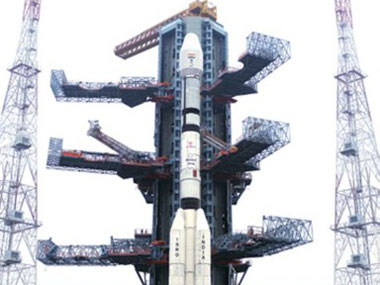Chennai:
The Indian rocket that will carry the 1,850 kg indigenous surveillance satellite – Radar Imaging Satellite (Risat-1) – to the skies this month will be controlled by the new mission control centre at Sriharikota, said a senior official of Indian space agency ISRO.
“The second mission control centre was inaugurated by President Pratibha Patil this January. The forthcoming rocket launch would be controlled and monitored from the new mission control centre. The rocket will fly off the first launch pad,” S Satish, director (publications and public relations), Indian Space Research Organisation (ISRO), told IANS.
ISRO has its rocket port at Sriharikota in Andhra Pradesh around 80 km from Chennai.
A senior ISRO official not wanting to be named told IANS: “The new mission control centre is modern and has larger area to accommodate more space scientists, officials, VIPs and others.”
 The satellite would be used for disaster prediction and agriculture forestry, and the high resolution pictures and microwave imaging could also be used for defence purposes.
The satellite would be used for disaster prediction and agriculture forestry, and the high resolution pictures and microwave imaging could also be used for defence purposes.
ISRO officials told IANS that the rocket Polar Satellite Launch Vehicle (PSLV) carrying remote sensing satellite Risat-1 is slated for launch from 25-30 April.
“The exact launch date depends on the readiness of the rocket and satellite systems. Normally it will take 12-14 days for the rocket launch after carrying out all the tests,” an ISRO official told IANS.
ISRO officials told IANS that Risat-1 systems are being checked at Sriharikota and it will be mated with the rocket later.
Once the satellite is loaded on to the rocket, the entire rocket systems would again be tested.
The PSLV rocket is in a fully assembled condition and is waiting for Risat-1, the heaviest microwave remote sensing satellite to be built by India. The satellite has all weather, day and night imaging capability.
The satellite would be used for disaster prediction and agriculture forestry, and the high resolution pictures and microwave imaging could also be used for defence purposes.
The satellite’s synthetic aperture radar (SAR) can acquire data at C-band. In 2009, ISRO had launched 300 kg Risat-2 with Israeli built SAR enabling earth observation in all weather, day and night conditions.
Remote sensing satellites send back pictures and other data for use. India has the largest constellation of remote sensing satellites in the world providing imagery in a variety of spatial resolutions, from more than a metre ranging up to 500 metres, and is a major player in vending such data in the global market.
According to ISRO officials, the rocket that would sling Risat-1 would be PSLV’s upgraded variant called PSLV-XL.
The rocket would weigh around 320 tonnes at lift-off and would be the third such expendable rocket to be sent up by ISRO.
IANS
source: http://www.firstpost.com / April 09th, 2012